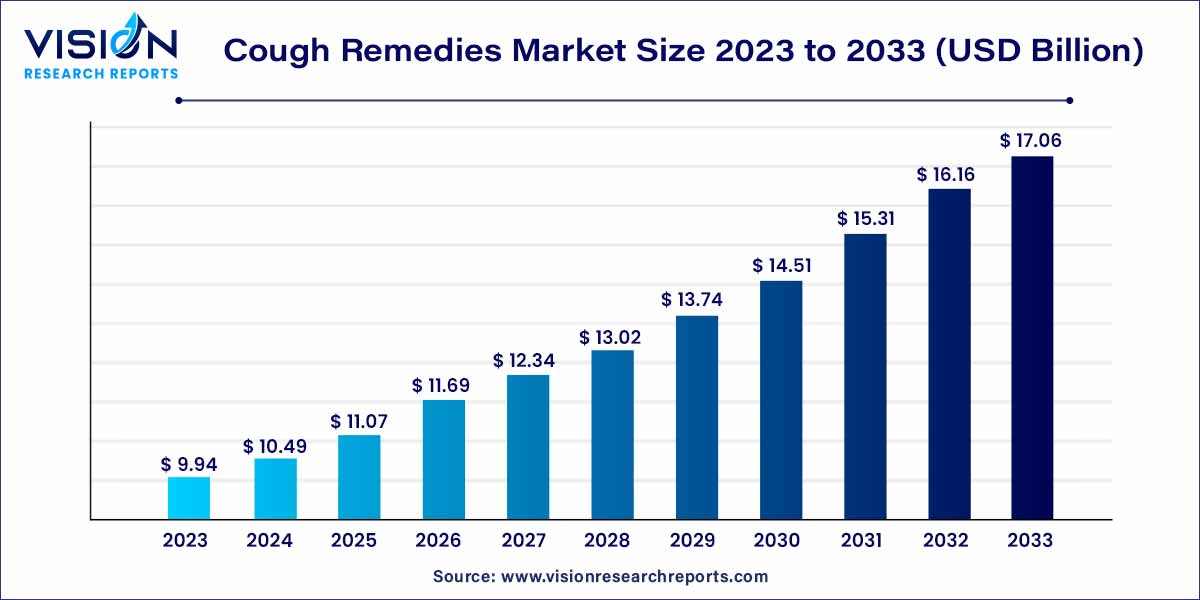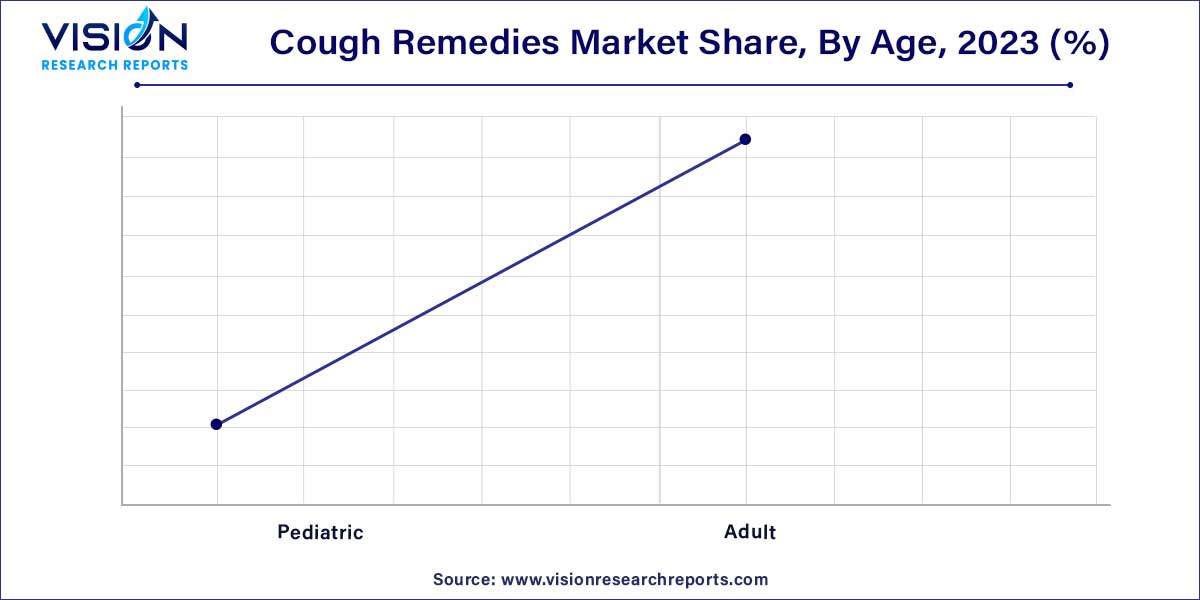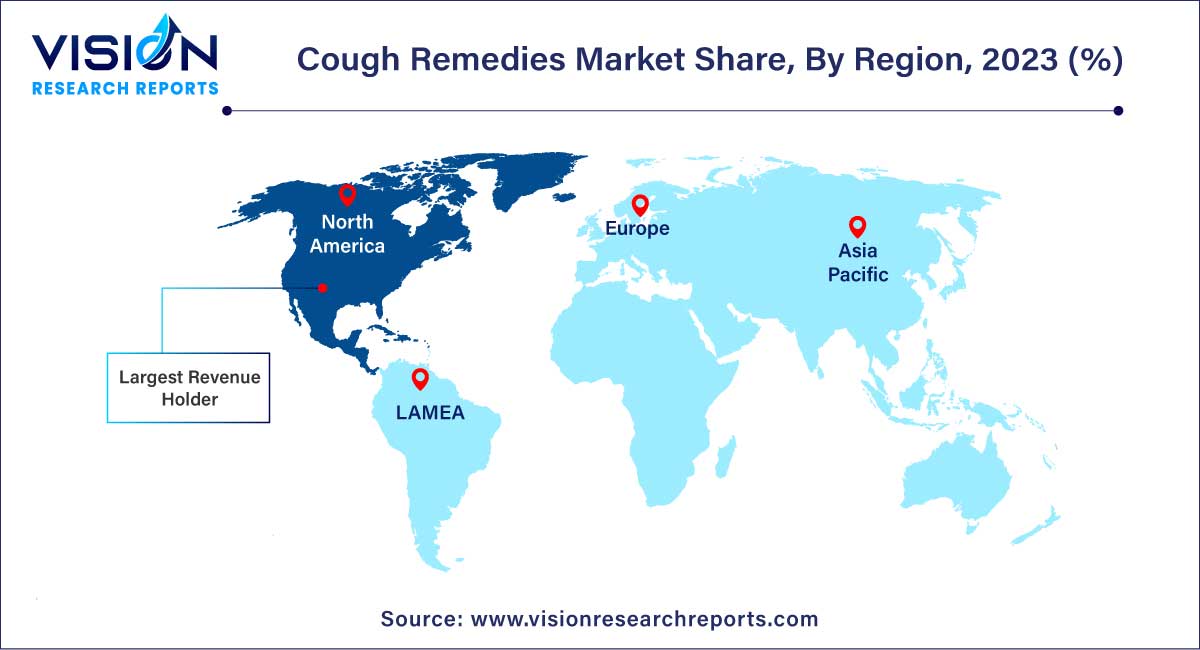The global cough remedies market size was estimated at around USD 9.94 billion in 2023 and it is projected to hit around USD 17.06 billion by 2033, growing at a CAGR of 5.55% from 2024 to 2033. The cough remedies market is driven by an increasing prevalence of respiratory ailments, growing health consciousness, continuous product innovation, and expansion of online retail channels.

The global cough remedies market is witnessing significant growth driven by various factors such as increasing prevalence of respiratory ailments, rising pollution levels, and growing awareness about self-care and over-the-counter (OTC) medications. Cough remedies encompass a wide range of products, including cough syrups, lozenges, tablets, and herbal remedies, catering to different types and severities of cough.
The growth of the cough remedies market is propelled by several key factors. Firstly, there's a rising prevalence of respiratory ailments worldwide, including conditions like asthma and bronchitis, which necessitates the need for effective cough remedies. Additionally, escalating pollution levels in urban areas contribute to respiratory irritations, driving the demand for cough relief products. Moreover, there's a notable increase in health consciousness among consumers, leading to a proactive approach towards managing minor ailments such as cough through over-the-counter remedies. Furthermore, continual product innovation by manufacturers, introducing new formulations and delivery methods, plays a pivotal role in expanding the market. Lastly, the proliferation of online retail channels provides consumers with convenient access to a wide array of cough remedies, further stimulating market growth. These factors collectively contribute to the robust expansion of the cough remedies market globally.
The cough remedies market is categorized into various types, including expectorants, antihistamines, bronchodilators, antibiotics, and others. In 2023, the expectorants segment emerged as the largest market segment. This dominance can be credited to the introduction of new expectorant products aimed at providing early relief. For instance, in November 2022, Genexa Inc. unveiled its inaugural cough and chest congestion remedy for adults. This product is distinguished by its artificial inactive ingredient-free formulation, designed to alleviate chest congestion and temporarily control and loosen mucus. Administered orally, it is available in the form of a liquid suspension.
The market is divided based on dosage form into oral syrup, tablets/pills, lozenges, and others. In 2023, the oral syrup segment dominated the market. This dominance is largely due to the extensive availability of oral syrup brands and their easy administration. Additionally, factors such as new product development, high efficacy, and swift drug delivery are contributing to the increased utilization of oral syrup products worldwide.
The cough remedies market is divided by age into pediatric and adult segments. In 2023, the adult segment emerged as the largest market segment. This is primarily because adults commonly experience acute and chronic coughs, often attributed to unhealthy lifestyles and increased exposure to tobacco.

Chronic cough, especially prevalent among older adults, significantly impacts quality of life, as evidenced by a 2020 study published by the European Respiratory Society indicating that approximately 10% of the adult population suffers from this condition. Consequently, the expanding adult population is expected to fuel the demand for cough remedies in the foreseeable future.
The cough remedies market is segmented based on distribution channels into retail and online pharmacies. In 2023, the retail pharmacy segment dominated the market. In Germany, for instance, approximately 18,068 community pharmacies, as reported by the Federal Union of German Associations of Pharmacists (ABDA), play a crucial role in meeting medical needs. The growth of this segment is supported by the availability of both branded and generic cough remedy products in retail pharmacy chains like Walgreens and Walmart Stores, Inc. Moreover, collaborations between hospitals and these pharmacy chains also contribute to the overall market expansion.
In 2023, North America emerged as the leader in market share. The region benefits from a sizable patient population and the presence of well-established manufacturers, factors expected to bolster market growth further. The rapid adoption of remedies in North America reflects growing concerns among a significant number of individuals regarding the health risks associated with persistent coughing.

Meanwhile, the Asia-Pacific region is projected to experience the fastest compound annual growth rate (CAGR) during the forecast period. This growth can be attributed to factors such as rapidly expanding healthcare expenditure, improvements in healthcare infrastructure, a rising geriatric population, and the increasing prevalence of respiratory diseases in the Asia-Pacific region.
By Type
By Dosage Form
By Age
By Distribution Channel
By Region
Chapter 1. Introduction
1.1. Research Objective
1.2. Scope of the Study
1.3. Definition
Chapter 2. Research Methodology
2.1. Research Approach
2.2. Data Sources
2.3. Assumptions & Limitations
Chapter 3. Executive Summary
3.1. Market Snapshot
Chapter 4. Market Variables and Scope
4.1. Introduction
4.2. Market Classification and Scope
4.3. Industry Value Chain Analysis
4.3.1. Raw Material Procurement Analysis
4.3.2. Sales and Distribution Channel Analysis
4.3.3. Downstream Buyer Analysis
Chapter 5. COVID 19 Impact on Cough Remedies Market
5.1. COVID-19 Landscape: Cough Remedies Industry Impact
5.2. COVID 19 - Impact Assessment for the Industry
5.3. COVID 19 Impact: Global Major Government Policy
5.4. Market Trends and Opportunities in the COVID-19 Landscape
Chapter 6. Market Dynamics Analysis and Trends
6.1. Market Dynamics
6.1.1. Market Drivers
6.1.2. Market Restraints
6.1.3. Market Opportunities
6.2. Porter’s Five Forces Analysis
6.2.1. Bargaining power of suppliers
6.2.2. Bargaining power of buyers
6.2.3. Threat of substitute
6.2.4. Threat of new entrants
6.2.5. Degree of competition
Chapter 7. Competitive Landscape
7.1.1. Company Market Share/Positioning Analysis
7.1.2. Key Strategies Adopted by Players
7.1.3. Vendor Landscape
7.1.3.1. List of Suppliers
7.1.3.2. List of Buyers
Chapter 8. Global Cough Remedies Market, By Type
8.1. Cough Remedies Market, by Type, 2024-2033
8.1.1. Expectorants
8.1.1.1. Market Revenue and Forecast (2021-2033)
8.1.2. Antihistamines
8.1.2.1. Market Revenue and Forecast (2021-2033)
8.1.3. Bronchodilators
8.1.3.1. Market Revenue and Forecast (2021-2033)
8.1.4. Antibiotics
8.1.4.1. Market Revenue and Forecast (2021-2033)
8.1.5. Others
8.1.5.1. Market Revenue and Forecast (2021-2033)
Chapter 9. Global Cough Remedies Market, By Dosage Form
9.1. Cough Remedies Market, by Dosage Form, 2024-2033
9.1.1. Oral Syrup
9.1.1.1. Market Revenue and Forecast (2021-2033)
9.1.2. Tablets/Pills
9.1.2.1. Market Revenue and Forecast (2021-2033)
9.1.3. Lozenges
9.1.3.1. Market Revenue and Forecast (2021-2033)
9.1.4. Others
9.1.4.1. Market Revenue and Forecast (2021-2033)
Chapter 10. Global Cough Remedies Market, By Age
10.1. Cough Remedies Market, by Age, 2024-2033
10.1.1. Pediatric
10.1.1.1. Market Revenue and Forecast (2021-2033)
10.1.2. Adult
10.1.2.1. Market Revenue and Forecast (2021-2033)
Chapter 11. Global Cough Remedies Market, By Distribution Channel
11.1. Cough Remedies Market, by Distribution Channel, 2024-2033
11.1.1. Retail
11.1.1.1. Market Revenue and Forecast (2021-2033)
11.1.2. Online Pharmacies
11.1.2.1. Market Revenue and Forecast (2021-2033)
Chapter 12. Global Cough Remedies Market, Regional Estimates and Trend Forecast
12.1. North America
12.1.1. Market Revenue and Forecast, by Type (2021-2033)
12.1.2. Market Revenue and Forecast, by Dosage Form (2021-2033)
12.1.3. Market Revenue and Forecast, by Age (2021-2033)
12.1.4. Market Revenue and Forecast, by Distribution Channel (2021-2033)
12.1.5. U.S.
12.1.5.1. Market Revenue and Forecast, by Type (2021-2033)
12.1.5.2. Market Revenue and Forecast, by Dosage Form (2021-2033)
12.1.5.3. Market Revenue and Forecast, by Age (2021-2033)
12.1.5.4. Market Revenue and Forecast, by Distribution Channel (2021-2033)
12.1.6. Rest of North America
12.1.6.1. Market Revenue and Forecast, by Type (2021-2033)
12.1.6.2. Market Revenue and Forecast, by Dosage Form (2021-2033)
12.1.6.3. Market Revenue and Forecast, by Age (2021-2033)
12.1.6.4. Market Revenue and Forecast, by Distribution Channel (2021-2033)
12.2. Europe
12.2.1. Market Revenue and Forecast, by Type (2021-2033)
12.2.2. Market Revenue and Forecast, by Dosage Form (2021-2033)
12.2.3. Market Revenue and Forecast, by Age (2021-2033)
12.2.4. Market Revenue and Forecast, by Distribution Channel (2021-2033)
12.2.5. UK
12.2.5.1. Market Revenue and Forecast, by Type (2021-2033)
12.2.5.2. Market Revenue and Forecast, by Dosage Form (2021-2033)
12.2.5.3. Market Revenue and Forecast, by Age (2021-2033)
12.2.5.4. Market Revenue and Forecast, by Distribution Channel (2021-2033)
12.2.6. Germany
12.2.6.1. Market Revenue and Forecast, by Type (2021-2033)
12.2.6.2. Market Revenue and Forecast, by Dosage Form (2021-2033)
12.2.6.3. Market Revenue and Forecast, by Age (2021-2033)
12.2.6.4. Market Revenue and Forecast, by Distribution Channel (2021-2033)
12.2.7. France
12.2.7.1. Market Revenue and Forecast, by Type (2021-2033)
12.2.7.2. Market Revenue and Forecast, by Dosage Form (2021-2033)
12.2.7.3. Market Revenue and Forecast, by Age (2021-2033)
12.2.7.4. Market Revenue and Forecast, by Distribution Channel (2021-2033)
12.2.8. Rest of Europe
12.2.8.1. Market Revenue and Forecast, by Type (2021-2033)
12.2.8.2. Market Revenue and Forecast, by Dosage Form (2021-2033)
12.2.8.3. Market Revenue and Forecast, by Age (2021-2033)
12.2.8.4. Market Revenue and Forecast, by Distribution Channel (2021-2033)
12.3. APAC
12.3.1. Market Revenue and Forecast, by Type (2021-2033)
12.3.2. Market Revenue and Forecast, by Dosage Form (2021-2033)
12.3.3. Market Revenue and Forecast, by Age (2021-2033)
12.3.4. Market Revenue and Forecast, by Distribution Channel (2021-2033)
12.3.5. India
12.3.5.1. Market Revenue and Forecast, by Type (2021-2033)
12.3.5.2. Market Revenue and Forecast, by Dosage Form (2021-2033)
12.3.5.3. Market Revenue and Forecast, by Age (2021-2033)
12.3.5.4. Market Revenue and Forecast, by Distribution Channel (2021-2033)
12.3.6. China
12.3.6.1. Market Revenue and Forecast, by Type (2021-2033)
12.3.6.2. Market Revenue and Forecast, by Dosage Form (2021-2033)
12.3.6.3. Market Revenue and Forecast, by Age (2021-2033)
12.3.6.4. Market Revenue and Forecast, by Distribution Channel (2021-2033)
12.3.7. Japan
12.3.7.1. Market Revenue and Forecast, by Type (2021-2033)
12.3.7.2. Market Revenue and Forecast, by Dosage Form (2021-2033)
12.3.7.3. Market Revenue and Forecast, by Age (2021-2033)
12.3.7.4. Market Revenue and Forecast, by Distribution Channel (2021-2033)
12.3.8. Rest of APAC
12.3.8.1. Market Revenue and Forecast, by Type (2021-2033)
12.3.8.2. Market Revenue and Forecast, by Dosage Form (2021-2033)
12.3.8.3. Market Revenue and Forecast, by Age (2021-2033)
12.3.8.4. Market Revenue and Forecast, by Distribution Channel (2021-2033)
12.4. MEA
12.4.1. Market Revenue and Forecast, by Type (2021-2033)
12.4.2. Market Revenue and Forecast, by Dosage Form (2021-2033)
12.4.3. Market Revenue and Forecast, by Age (2021-2033)
12.4.4. Market Revenue and Forecast, by Distribution Channel (2021-2033)
12.4.5. GCC
12.4.5.1. Market Revenue and Forecast, by Type (2021-2033)
12.4.5.2. Market Revenue and Forecast, by Dosage Form (2021-2033)
12.4.5.3. Market Revenue and Forecast, by Age (2021-2033)
12.4.5.4. Market Revenue and Forecast, by Distribution Channel (2021-2033)
12.4.6. North Africa
12.4.6.1. Market Revenue and Forecast, by Type (2021-2033)
12.4.6.2. Market Revenue and Forecast, by Dosage Form (2021-2033)
12.4.6.3. Market Revenue and Forecast, by Age (2021-2033)
12.4.6.4. Market Revenue and Forecast, by Distribution Channel (2021-2033)
12.4.7. South Africa
12.4.7.1. Market Revenue and Forecast, by Type (2021-2033)
12.4.7.2. Market Revenue and Forecast, by Dosage Form (2021-2033)
12.4.7.3. Market Revenue and Forecast, by Age (2021-2033)
12.4.7.4. Market Revenue and Forecast, by Distribution Channel (2021-2033)
12.4.8. Rest of MEA
12.4.8.1. Market Revenue and Forecast, by Type (2021-2033)
12.4.8.2. Market Revenue and Forecast, by Dosage Form (2021-2033)
12.4.8.3. Market Revenue and Forecast, by Age (2021-2033)
12.4.8.4. Market Revenue and Forecast, by Distribution Channel (2021-2033)
12.5. Latin America
12.5.1. Market Revenue and Forecast, by Type (2021-2033)
12.5.2. Market Revenue and Forecast, by Dosage Form (2021-2033)
12.5.3. Market Revenue and Forecast, by Age (2021-2033)
12.5.4. Market Revenue and Forecast, by Distribution Channel (2021-2033)
12.5.5. Brazil
12.5.5.1. Market Revenue and Forecast, by Type (2021-2033)
12.5.5.2. Market Revenue and Forecast, by Dosage Form (2021-2033)
12.5.5.3. Market Revenue and Forecast, by Age (2021-2033)
12.5.5.4. Market Revenue and Forecast, by Distribution Channel (2021-2033)
12.5.6. Rest of LATAM
12.5.6.1. Market Revenue and Forecast, by Type (2021-2033)
12.5.6.2. Market Revenue and Forecast, by Dosage Form (2021-2033)
12.5.6.3. Market Revenue and Forecast, by Age (2021-2033)
12.5.6.4. Market Revenue and Forecast, by Distribution Channel (2021-2033)
Chapter 13. Company Profiles
13.1. BAYER AG
13.1.1. Company Overview
13.1.2. Product Offerings
13.1.3. Financial Performance
13.1.4. Recent Initiatives
13.2. GLAXOSMITHKLINE PLC
13.2.1. Company Overview
13.2.2. Product Offerings
13.2.3. Financial Performance
13.2.4. Recent Initiatives
13.3. PROCTER & GAMBLE (P&G)
13.3.1. Company Overview
13.3.2. Product Offerings
13.3.3. Financial Performance
13.3.4. Recent Initiatives
13.4. PFIZER, INC.
13.4.1. Company Overview
13.4.2. Product Offerings
13.4.3. Financial Performance
13.4.4. Recent Initiatives
13.5. JOHNSON & JOHNSON
13.5.1. Company Overview
13.5.2. Product Offerings
13.5.3. Financial Performance
13.5.4. Recent Initiatives
13.6. SUN PHARMACEUTICALS INDUSTRIES LIMITED
13.6.1. Company Overview
13.6.2. Product Offerings
13.6.3. Financial Performance
13.6.4. Recent Initiatives
13.7. Novartis International AG
13.7.1. Company Overview
13.7.2. Product Offerings
13.7.3. Financial Performance
13.7.4. Recent Initiatives
13.8. Reckitt Benckiser Group plc.
13.8.1. Company Overview
13.8.2. Product Offerings
13.8.3. Financial Performance
13.8.4. Recent Initiatives
13.9. PRESTIGE BRANDS INC.
13.9.1. Company Overview
13.9.2. Product Offerings
13.9.3. Financial Performance
13.9.4. Recent Initiatives
13.10. ASTRAZENECA PLC
13.10.1. Company Overview
13.10.2. Product Offerings
13.10.3. Financial Performance
13.10.4. Recent Initiatives
Chapter 14. Research Methodology
14.1. Primary Research
14.2. Secondary Research
14.3. Assumptions
Chapter 15. Appendix
15.1. About Us
15.2. Glossary of Terms
 Cross-segment Market Size and Analysis for
Mentioned Segments
Cross-segment Market Size and Analysis for
Mentioned Segments
 Additional Company Profiles (Upto 5 With No Cost)
Additional Company Profiles (Upto 5 With No Cost)
 Additional Countries (Apart From Mentioned Countries)
Additional Countries (Apart From Mentioned Countries)
 Country/Region-specific Report
Country/Region-specific Report
 Go To Market Strategy
Go To Market Strategy
 Region Specific Market Dynamics
Region Specific Market Dynamics Region Level Market Share
Region Level Market Share Import Export Analysis
Import Export Analysis Production Analysis
Production Analysis Others
Others